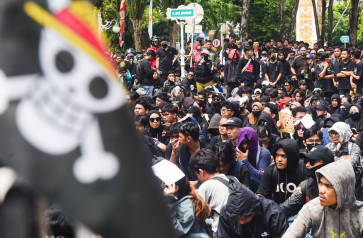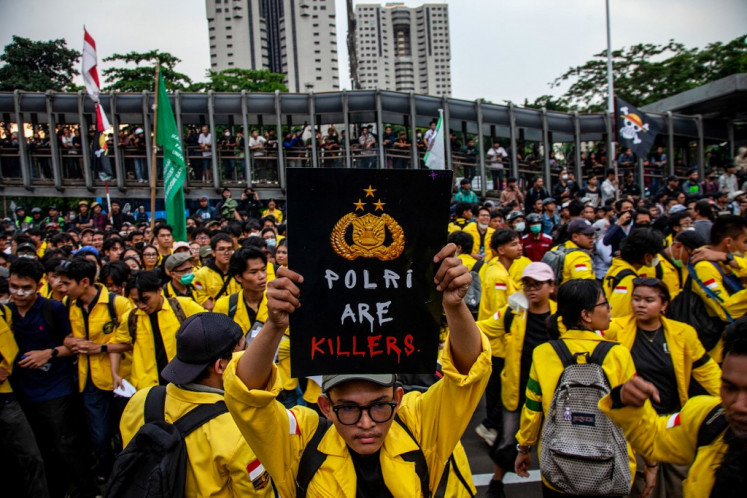Popular Reads
Top Results
Can't find what you're looking for?
View all search resultsPopular Reads
Top Results
Can't find what you're looking for?
View all search resultsWorkers in ASEAN: A race to the bottom again?
The ASEAN region is about to enter one of its most ambitious integration schemes with the start of the ASEAN Economic Community (AEC) in December 2015
Change text size
Gift Premium Articles
to Anyone
T
he ASEAN region is about to enter one of its most ambitious integration schemes with the start of the ASEAN Economic Community (AEC) in December 2015. Despite the partial nature of the economic integration itself, it will inevitably bring a significant transformation to interactions between member countries. As the deadline approaches, concerns arise not only on whether ASEAN members are ready, but also on whether plans of regulating specific issues proposed under ASEAN social initiatives will stall further after the establishment of the AEC.
This is particularly true with regards to ASEAN's effort to come up with a legally binding instrument to protect the rights of migrant workers under the ASEAN framework.
Although ASEAN achieved a milestone with the 2007 Cebu Declaration for the Protection and Promotion of the Rights of Migrant Workers, negotiations stalled in 2008.
Preparations under the AEC have shifted the focus toward an ASEAN legally binding instrument for migrant workers protection. This condition is particularly important given AEC's support of freer movement of skilled labor that will shift skilled jobs away from countries, deepening the gap in skills among ASEAN members.
The establishment of the ASEAN Economic Community has been agreed upon by ASEAN members since 2003 under ASEAN's Vision 2020, which implied that the AEC would start in 2020.
It was only in 2007 that ASEAN member countries resolved to speed up the AEC to 2015 in AEC Blueprint, heavily supported by Indonesia and increasing market-oriented economies such as Vietnam and Singapore.
Analysts and skeptics alike began to question whether this represents a goal too ambitious for such a complicated institution and if ASEAN has bitten off more than it can chew.
Workers' migration in ASEAN represents the contour of inequalities between ASEAN members. Indonesia, the leading labor exporting country in ASEAN, has 1.5 million workers working within ASEAN countries, whilst Malaysia imports 1.8 million workers from other ASEAN neighbors, with Singapore coming in second, importing 1.2 million workers from the region.
This follows the fact that unemployment rates in worker exporting countries such as Indonesia is as high as 6.6 percent and 7.12 percent in the Philippines, compared to 2.5 percent in Singapore.
The AEC is predicted to boost the region's economies by 7.1 per cent by 2025, generate 14 million additional jobs and increase decent jobs and workers' skills.
However, gains from the establishment of AEC in such a diverse and unequal region may not be evenly distributed.
As changes in sectoral distribution of employment increasingly shift the types of occupations in demand, the increase of vulnerable employment is estimated at 55 percent.
Continued lack of recognition of domestic and undocumented migrant workers under regulations within ASEAN countries supports the prediction that this number may rise.
The imminent threat of the decline of the agricultural sector, the obstruction of rural development and the destruction of rural lands to make room for modern development forces more jobs and workers out of rural areas resulting in an overflow of low and unskilled workers to other areas and countries. Therefore, the migration of low and unskilled workers is predicted to still increase in the following years.
The main transformation under the AEC Blueprint that will directly affect the migration of workers and conditions in ASEAN will be one of the four core elements under its aim for a 'single market and production base' and a 'free flow of skilled labor.'
Preparations of the AEC concerning workers migration revolve around enhancing cooperation and developing core competencies and qualifications including training in prioritized sectors.
As the focus on freer movement under this regulation will be skilled labor, it suggests firstly that most migrant workers in ASEAN, mostly low or unskilled laborers, will be disregarded.
Secondly, this component of the AEC also suggests that a mechanism of skills standardization will take place, which begs the question of how this standard will be applied.
This dynamic is in opposition to the fact that in ASEAN unskilled workers make up the majority of migrant workers at 87 percent, with a large number coming from lower per capita income countries such as Cambodia, Indonesia and the Philippines.
Without sufficient protection, freer flow of higher skilled workers will not only force higher qualified jobs in the region to be dominated by workers from higher-income ASEAN countries, but would further push unskilled and low skilled workers to face competition from medium skilled workers that are forced to downgrade their employment as a cost of external competition.
The ASEAN Economic Community may offer numerous benefits in allowing more trade, and business openness will support the regional economy in facing competition from other regions.
Yet, the AEC's effect on skilled and migrant workers should not be one that ASEAN countries take lightly.
Changes in labor interactions within a country will bring alterations in migration, consumption and production trends that determine the region's economy.
Conclusively, the AEC will have to increase protection of ASEAN's workers to avoid further inequality in ASEAN ' consequently failing to achieve its own goals of economic development that would allow ASEAN to establish itself as a global economic power.
________________
Workers' migration in ASEAN represents the contour of inequalities between ASEAN members.
_____________________
The writer is research manager at the Graduate School of Multidisciplinary Studies at the University of Indonesia.










